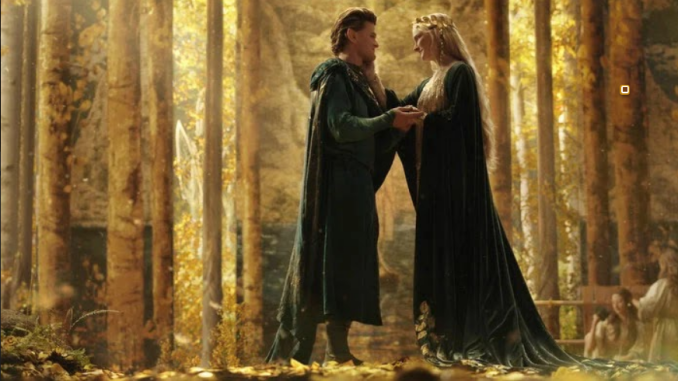
By Patrick Boyd Richardson
One of the best high fantasy authors to ever live, J.R.R. Tolkien, has his beloved mythology “Lord of the Rings” honored again. Tolkien’s work, or legendarium to Tolkien fanatics, is spectacular in description and euphonic in its linguistic detail. And the newest “The Rings of Power” series on Amazon Prime shows a brilliant homage to Tolkien’s vision, or at least would have, had the plot been more intensified with the appropriate gore and violence familiar to Tolkien fans worldwide.
I truly think the level of sophistication that Tolkien – the inventor of fantasy as a popular literary genre – aspired to in his world-building is not satisfactorily reflected in this series.
Set in Numenor, “The Rings of Power” ambitiously prequels the 20-year-old “Lord of the Rings” trilogy, but it’s decidedly tepid in its delivery. Not reaching the heights of the original Peter Jackson films, the series steals the set design and wardrobe queues from the original films with peculiar candor yet falter in every other aspect. They are monotone and do not take necessary risks. Now to be fair, any Amazon Prime series isn’t going to hold a candle to a major motion picture from a Hollywood production company, even if it was released roughly 20 years ago in theaters everywhere.
The casting is clever but challenging to say the least. Like the original film trilogy, the characters are not portrayed by extremely well-known actors, at least starting out in the show. The inability to introduce a character’s persona swells up into a serious problem because of this
anonymity. Fortunately, as the show goes on, you can weave together the personalities a bit
better – it just takes too much time. The exposition in the show is so paltry it often does not plug these gaps in the narrative.
Throughout the series, elves superabound. The young Elrond character is particularly
good, and Celebrimbor is not bad either. However, these elves talk in circles about elven family and elven politics. You are expected to Google to find out what they are referring to, which, to be fair, is often interesting.
Take the case of Earendil, Elrond’s half-elf father who is never but is established from the beginning to have disappeared. They don’t really explain that he was turned into a giant star in the sky by the Valar (gods), they just let you feel sorry for his son because his dad is either dead or missing. Google shouldn’t be an active part of any viewing, but in this series the fandom is so massive and the lore so deep, it can only be necessary. This isn’t a bad thing, it is
quite good since it really is a loving compliment to the immense imagination and perfectionism of Tolkein’s world-building.
There are some issues the show’s, which is hilarious considering the astronomical budget. I cannot decry the poor quality of the cinematography. While the lighting is appropriately fabulous, the angles and framing lend to an abysmally irresponsible shot selection. This, mind you, is throughout the five episodes that were altogether boring in their frequency of action and impossible in any ability to be clever for the many dialogue-heavy moments.
The problem is officially the lack of death or even thematic focus on it. The five episodes so far in the introductory season seem to hover around the idea of doom and devastation, but the
destruction is never felt-imminent or actualized – it’s merely a mirage the entire time.
Like a deus ex machina, the hero-of-the-moment is always saved by some side character or paternal figure or, nay I say, a divinely-inspired Eldar. This happens within the Southlander territory a lot. These people die more often than the Numenoreans because they were cursed for siding with Melkor, the never-been-filmed supervillain and evil god from the First Age.
The death of the Numenoreans isn’t a flavor we can fully taste, but only wonder upon from afar either. This is ironic considering that the island of Numenor (spoiler) is later utterly torn apart with genocidal consequences.
Repeat characters like Galadriel, Sauron, and Isildur are welcome. But, they are surprisingly sidelined in the wake of a self-important, machinating, small village that desires a kind of cheap, video game survival. Its characters aren’t fundamentally interesting, yet we are exposed to their travails as though they were the continuation of the Hobbit’s Bilbo, just in a different cloth of race on an entirely different continent yet still in the Tolkien world.
I had a hard time understanding how the characters became so racialized after many films have established the world as being predominantly white. The show doesn’t miss any punches because more characters are racially ambiguous than in other Tolkien-inspired works. One tends to think the likelihood of diverse skin color is questionable in a world where the races aren’t ethnic but based rather on how powerful a sentient species is: elf, human, dwarf, hobbit. Yet, the very idea that skin color could vary between typically monocolored groups like the elves or the dwarves is quaint and somehow realistic. The notion that skin color changes like hair color is a powerful one in this series.
Without any illuminating qualities, the fails to pack the same wizardry punch the original trilogy knew so well. Maybe the showrunners and script writers should read less Tolkien’s fairytales, and more John Milton’s religious epics since he was someone who established the particular moral style Tolkien employs. Milton is essential to Tolkein, at least if “The Rings of Power” want to show naturalistic, pompous, and quasi-religious veins famous in Middle-Earth speech.
